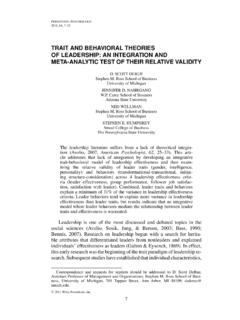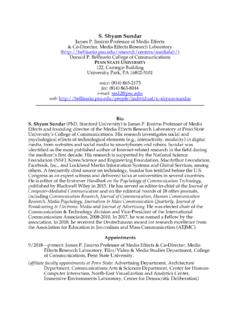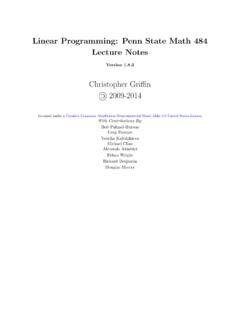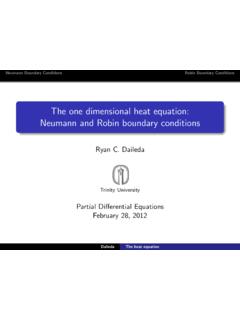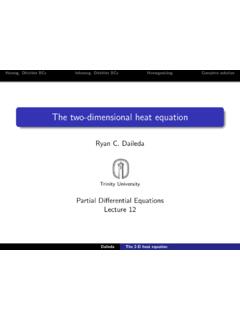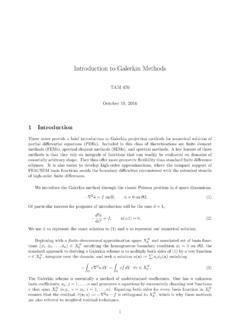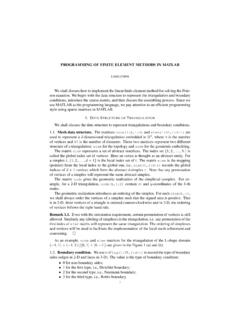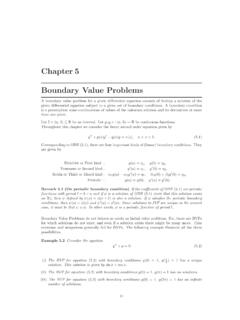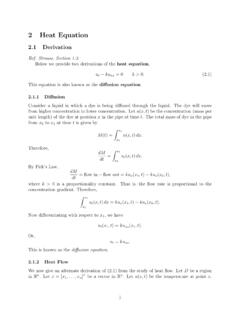Transcription of Second Order Linear Partial Differential Equations Part I
1 2008, 2012 Zachary S Tseng E 1 1 Second Order Linear Partial Differential Equations Part I Second Linear Partial Differential Equations ; Separation of Variables; 2 point boundary value problems; Eigenvalues and Eigenfunctions Introduction We are about to study a simple type of Partial Differential Equations (PDEs): the Second Order Linear PDEs. Recall that a Partial Differential equation is any Differential equation that contains two or more independent variables. Therefore the derivative(s) in the equation are Partial derivatives. We will examine the simplest case of Equations with 2 independent variables. A few examples of Second Order Linear PDEs in 2 variables are: 2 uxx = ut (one dimensional heat conduction equation) a2 uxx = utt (one dimensional wave equation) uxx + uyy = 0 (two dimensional Laplace/potential equation) In this class we will develop a method known as the method of Separation of Variables to solve the above types of Equations .
2 2008, 2012 Zachary S Tseng E 1 2 (Optional topic) Classification of Second Order Linear PDEs Consider the generic form of a Second Order Linear Partial Differential equation in 2 variables with constant coefficients: a uxx + b uxy + c uyy + d ux + e uy + f u = g(x,y). For the equation to be of Second Order , a, b, and c cannot all be zero. Define its discriminant to be b2 4ac. The properties and behavior of its solution are largely dependent of its type, as classified below. If b2 4ac > 0, then the equation is called hyperbolic. The wave equation is one such example. If b2 4ac = 0, then the equation is called parabolic. The heat conduction equation is one such example. If b2 4ac < 0, then the equation is called elliptic. The Laplace equation is one such example.
3 In general, elliptic Equations describe processes in equilibrium. While the hyperbolic and parabolic Equations model processes which evolve over time. Example: Consider the one dimensional damped wave equation 9uxx = utt + 6ut. It can be rewritten as: 9uxx utt 6ut = 0. It has coefficients a = 9, b = 0, and c = 1. Its discriminant is 9 > 0. Therefore, the equation is hyperbolic. 2008, 2012 Zachary S Tseng E 1 3 The One-Dimensional Heat Conduction Equation Consider a thin bar of length L, of uniform cross section and constructed of homogeneous material. Suppose that the side of the bar is perfectly insulated so no heat transfer could occur through it (heat could possibly still move into or out of the bar through the two ends of the bar). Thus, the movement of heat inside the bar could occur only in the x direction.
4 Then, the amount of heat content at any place inside the bar, 0 < x < L, and at any time t > 0, is given by the temperature distribution function u(x, t). It satisfies the homogeneous one dimensional heat conduction equation: 2 uxx = ut Where the constant coefficient 2 is the thermo diffusivity of the bar, given by 2 = k / s. (k = thermal conductivity, = density, s = specific heat, of the material of the bar.) Further, let us assume that both ends of the bar are kept constantly at 0 degree temperature (abstractly, by connecting them both to a heat reservoir 2008, 2012 Zachary S Tseng E 1 4 of the same temperature; more practically, say they are immersed in iced water). This assumption imposes explicit restriction on the bar s ends, in this case: u(0, t) = 0, and u(L, t) = 0.
5 T > 0 Those two conditions are called the boundary conditions of this problem. They literally specify the conditions present at the boundaries between the bar and the outside. Think them as the environmental factors of the given problem. In addition, there is an initial condition: the initial temperature distribution within the bar, u(x, 0). It is a snapshot of the temperature everywhere inside the bar at t = 0. Therefore, it is an (arbitrary) function of the spatial variable x only. That is, the initial condition is u(x, 0) = f (x). Hence, what we have is a problem given by: (Heat conduction eq.) 2 uxx = ut , 0 < x < L, t > 0, ( boundary conditions ) u(0, t) = 0, and u(L, t) = 0, (Initial condition) u(x, 0) = f (x). This is an example of what is known, formally, as an initial boundary value problem.
6 Although it is still true that we will find a general solution first, then apply the initial condition to find the particular solution. A major difference now is that the general solution is dependent not only on the equation, but also on the boundary conditions . In other words, the given Partial Differential equation will have different general solutions when paired with different sets of boundary conditions . 2008, 2012 Zachary S Tseng E 1 5 If the boundary conditions specify u, u(0, t) = f (t) and u(L, t) = g(t), then they are often called Dirichlet conditions . If they specify the (spatial) derivative, ux(0, t) = f (t) and ux(L, t) = g(t), then they are often called Neumann conditions . If the boundary conditions are Linear combinations of u and its derivative, u(0, t) + ux(0, t) = f (t), then they are called robin conditions .
7 Those are the 3 most common classes of boundary conditions . If the specified functions in a set of condition are all equal to zero, then they are homogeneous. Our current example, therefore, is a homogeneous Dirichlet type problem. But before any of those boundary and initial conditions could be applied, we will first need to process the given Partial Differential equation. What can we do with it? There are other tools (by Laplace transforms, for example), but the most accessible method to us is called the method of Separation of Variables. The idea is to somehow de couple the independent variables, therefore rewrite the single Partial Differential equation into 2 ordinary Differential Equations of one independent variable each (which we already know how to solve). We will solve the 2 Equations individually, and then combine their results to find the general solution of the given Partial Differential equation.
8 For a reason that should become clear very shortly, the method of Separation of Variables is sometimes called the method of Eigenfunction Expansion. 2008, 2012 Zachary S Tseng E 1 6 Separation of Variables Start with the one dimensional heat conduction equation 2 uxx = ut . Suppose that its solution u(x, t) is such a function that it can be expressed as a product, u(x, t) = X(x)T(t), where X is a function of x alone and T is a function of t alone. Then, its Partial derivatives can also be expressed simply by: u = X T uxx = X T ux = X T utt = X T ut = X T uxt = utx = X T Hence, the heat conduction equation 2 uxx = ut can be rewritten as 2 X T = X T . Dividing both sides by 2 X T : TTXX2 = ( 2 is a constant, so it could go to either side of the equation, but it is usually, and more conveniently, moved to the t side.)
9 The equation is now separated , as all the x terms are on the left and t terms are on the right. Note: The above step would not have been possible if either X = 0 or T = 0. However, if either part is zero, then u = XT = 0, which will trivially satisfy the given equation 2 uxx = ut . This constant zero solution is called the trivial solution of the equation. We know this is going to be the case. Therefore, we will assume from this point onward that X 0 and T 0. We look for only the nonzero solutions. 2008, 2012 Zachary S Tseng E 1 7 But how do we completely pull it apart into 2 Equations ? The critical idea here is that, because the independent variables x and t can, and do, vary independently, in Order for the above equation to hold for all values of x and t, the expressions on both sides of the equation must be equal to the same constant.
10 Let us call the constant . It is called the constant of separation. (The negative sign is optional, of course, since is an arbitrary number and it could be either positive or negative or even zero. But putting a negative sign here right now makes our later calculation a little easier.) Thus, = = TTXX2. Why must the two sides be the same constant? Well, think what would happen if one of the sides isn t a constant. The equation would not be true for all x and t if that were the case, because then one side/variable could be held at a fixed value while the other side/variable changes. Next, equate first the x term and then the t term with . We have = XX X = X X + X = 0, and, = TT2 T = 2 T T + 2 T = 0. Consequently, the single Partial Differential equation has now been separated into a simultaneous system of 2 ordinary Differential Equations .




